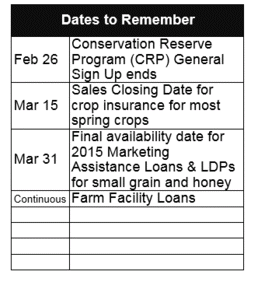|
 The microloan program, which recently celebrated its third
anniversary, has been hugely successful, providing more than
16,800 low-interest loans, totaling over $373 million to
producers across the country. Microloans have helped farmers and
ranchers with operating costs, such as feed, fertilizer, tools,
fencing, equipment, and living expenses since 2013. Seventy
percent of loans have gone to new farmers. The microloan program, which recently celebrated its third
anniversary, has been hugely successful, providing more than
16,800 low-interest loans, totaling over $373 million to
producers across the country. Microloans have helped farmers and
ranchers with operating costs, such as feed, fertilizer, tools,
fencing, equipment, and living expenses since 2013. Seventy
percent of loans have gone to new farmers.
Now, microloans will be available to also help with farm land
and building purchases, and soil and water conservation
improvements. FSA designed the expanded program to simplify the
application process, expand eligibility requirements and
expedite smaller real estate loans to help farmers strengthen
their operations. Microloans provide up to $50,000 to qualified
producers, and can be issued to the applicant directly from the
USDA Farm Service Agency (FSA).
This microloan announcement is another USDA resource for
America’s farmers and ranchers to utilize, especially as new and
beginning farmers and ranchers look for the assistance they need
to get started. To learn more about the FSA microloan program
visit
www.fsa.usda.gov/ microloans , or contact your local FSA
office. To find your nearest office location, please visit
http://offices.usda.gov.

USDA Sees Strong Demand for Conservation Reserve Program
USDA reminds farmers and ranchers that the competitive sign-up
deadline for its most popular voluntary conservation program,
the Conservation Reserve Program (CRP), is Feb. 26, 2016. This
will be one of the most competitive general sign-up periods in
history, in part due a statutory limit on the number of acres
that can be enrolled in the program. The most competitive
applications will be those that combine multiple conservation
benefits, such as water quality and wildlife habitat.
For the past thirty years, CRP has provided financial incentives
to farmers and ranchers to remove environmentally sensitive
agricultural land from production to be planted with certain
grasses, shrubs and trees that improve water quality, prevent
soil erosion and increase wildlife habitat. Since 1985, CRP has
sequestered an annual average of 49 million tons of greenhouse
gases, equal to taking 9 million cars off the road; prevented 9
billion tons of soil from erosion, enough to fill 600 million
dump trucks; and reduced nitrogen and phosphorous runoff by 95
and 85 percent, respectively. CRP also protects more than
170,000 stream miles with forests and grasses, enough to go
around the world seven times. The program has allowed for the
restoration of 2.7 million acres of wetland.
As of January 2016, 23.6 million acres were enrolled in CRP,
with contracts for more than 1.6 million acres set to expire
this fall. The statutory cap on acres that can be enrolled is 24
million acres. Submissions will be ranked according to
environmental benefits in comparison to all other offers
nationwide. USDA will announce accepted offers after the
enrollment period ends and offers are reviewed. For an
interactive tour of CRP success stories from across the U.S.,
visit
www.fsa.usda.gov/CRPis30 , or follow on Twitter at #CRPis30.
For an interactive look at USDA's work in conservation and
forestry over the course of this Administration, visit
http://medium.com/usda-results
USDA Removes Farm Program Payments to Managers Not Actively
Engaged in Farming
USDA finalized a rule to ensure that farm safety-net payments
are issued only to active managers of farms that operate as
joint ventures or general partnerships, consistent with the
direction and authority provide by Congress in the 2014 Farm
Bill. The action, which exempts family farm operations, closes a
loophole where individuals who were not actively part of farm
management still received payments.

Since 1987, the broad definition of “actively engaged” resulted
in some general partnerships and joint ventures adding managers
to the farming operation, qualifying for more payments that did
not substantially contribute to management. The rule applies to
operations seeking more than one farm manager, and requires
measureable, documented hours and key management activities each
year. Some operations of certain sizes and complexity may be
allowed up to three qualifying managers under limited
conditions. The changes apply to payments for 2016 and
subsequent crop years for Agriculture Risk Coverage (ARC) and
Price Loss Coverage (PLC) Programs, Loan Deficiency Payments
(LDP) and Marketing Loan Gains (MLG) realized via the Marketing
Assistance Loan program.
As required by Congress, the new rule does not apply to family
farms, or change regulations related to contributions of land,
capital, equipment, or labor. The changes go into effect for the
2016 crop year for most farms. Farms that have already planted
fall crops for 2016 have until the 2017 crop year to comply. For
more details, producers are encouraged to consult their local
Farm Service Agency office.
Farm Storage Facility Loans
FSA’s Farm Storage Facility Loan (FSFL) program provides
low-interest financing to producers to build or upgrade storage
facilities.
The low-interest funds can be used to build or upgrade permanent
facilities to store commodities. Eligible commodities include
corn, grain sorghum, rice, soybeans, oats, peanuts, wheat,
barley, minor oilseeds harvested as whole grain, pulse crops
(lentils, chickpeas and dry peas), hay, honey, renewable
biomass, fruits, nuts and vegetables for cold storage
facilities, floriculture, hops, maple sap, rye, milk, cheese,
butter, yogurt, meat and poultry (unprocessed), eggs, and
aquaculture (excluding systems that maintain live animals
through uptake and discharge of water). Qualified facilities
include grain bins, hay barns and cold storage facilities for
eligible commodities.
Loans up to $100,000 can be secured by a promissory
note/security agreement. FSFLs between $100,000 and $500,000
will require additional security.
Producers do not need to demonstrate the lack of commercial
credit availability to apply. The loans are designed to assist a
diverse range of farming operations, including small and
mid-sized businesses, new farmers, operations supplying local
food and farmers markets, non-traditional farm products, and
underserved producers.
To learn more about the FSA Farm Storage Facility Loan, visit
www.fsa.usda.gov/
pricesupport or contact your local FSA county office.
To find your local FSA county office, visit
http://offices.usda.gov.

February Interest Rates


CRP Payment Limitation
Payments and benefits received under the Conservation Reserve
Program (CRP) are subject to the following:
- payment limitation by direct attribution
- foreign person rule
- average adjusted gross income (AGI) limitation

The 2014 Farm Bill continued the $50,000 maximum CRP payment
amount that can be received annually, directly or indirectly, by
each person or legal entity. This payment limitation includes
all annual rental payments and incentive payments (Sign-up
Incentive Payments and Practice Incentive Payments). Annual
rental payments are attributed (earned) in the fiscal year in
which program performance occurs. Sign-up Incentive Payments
(SIP) are attributed (earned) based on the fiscal year in which
the contract is approved, not the fiscal year the contract is
effective. Practice Incentive Payments (PIP) are attributed
(earned) based on the fiscal year in which the cost-share
documentation is completed and the producer or technical service
provider certifies performance of practice completion to the
county office.
[to top of second column] |

Such limitation on payments is controlled by direct attribution.
- Program payments made directly or indirectly to a person are
combined with the pro rata interest held in any legal entity
that received payment, unless the payments to the legal entity
have been reduced by the pro rata share of the person.
- Program payments made directly to a legal entity are
attributed to those persons that have a direct and indirect
interest in the legal entity, unless the payments to the legal
entity have been reduced by the pro rata share of the person.
- Payment attribution to a legal entity is tracked through
four levels of ownership. If any part of the ownership interest
at the fourth level is owned by another legal entity, a
reduction in payment will be applied to the payment entity in
the amount that represents the indirect interest of the fourth
level entity in the payment entity.
Essentially, all payments will be “attributed” to a person’s
Social Security Number. Given the current CRP annual rental
rates in many areas, it is important producers are aware of how
CRP offered acreages impact their $50,000 annual payment
limitation. Producers should contact their local FSA office for
additional information.
NOTE: The information in the above article only applies to
contracts subject to 4-PL and 5-PL regulations. It does not
apply to contacts subject to 1-PL regulations.
Farm Reconstitutions
When changes in farm ownership or operation take place, a farm
reconstitution is necessary. The reconstitution — or recon — is
the process of combining or dividing farms or tracts of land
based on the farming operation.
The following are the different methods used when doing a farm
recon.
Estate Method — the division of bases, allotments and
quotas for a parent farm among heirs in settling an estate;
Designation of Landowner Method — may be used when (1)
part of a farm is sold or ownership is transferred; (2) an
entire farm is sold to two or more persons; (3) farm ownership
is transferred to two or more persons; (4) part of a tract is
sold or ownership is transferred; (5) a tract is sold to two or
more persons; or (6) tract ownership is transferred to two or
more persons. In order to use this method the land sold must
have been owned for at least three years, or a waiver granted,
and the buyer and seller must sign a Memorandum of
Understanding;

DCP Cropland Method — the division of bases in the same
proportion that the DCP cropland for each resulting tract
relates to the DCP cropland on the parent tract;
Default Method — the division of bases for a parent farm
with each tract maintaining the bases attributed to the tract
level when the reconstitution is initiated in the system.
Disaster Set-Aside (DSA) Program
FSA borrowers with farms located in designated primary or
contiguous disaster areas who are unable to make their scheduled
FSA loan payments should consider the Disaster Set-Aside (DSA)
program.
DSA is available to producers who suffered losses as a result of
a natural disaster and is intended to relieve immediate and
temporary financial stress. FSA is authorized to consider
setting aside the portion of a payment/s needed for the
operation to continue on a viable scale.
Borrowers must have at least two years left on the term of their
loan in order to qualify.
Borrowers have eight months from the date of the disaster
designation to submit a complete application. The application
must include a written request for DSA signed by all parties
liable for the debt along with production records and financial
history for the operating year in which the disaster occurred.
FSA may request additional information from the borrower in
order to determine eligibility.
All farm loans must be current or less than 90 days past due at
the time the DSA application is complete. Borrowers may not set
aside more than one installment on each loan.
The amount set-aside, including interest accrued on the
principal portion of the set-aside, is due on or before the
final due date of the loan.
For more information, contact your local FSA farm loan office.
Farm Loan Graduation Reminder
FSA Direct Loans are considered a temporary source of credit
that is available to producers who do not meet normal
underwriting criteria for commercial banks.
FSA periodically conducts Direct Loan graduation reviews to
determine a borrower’s ability to graduate to commercial credit.
If the borrower’s financial condition has improved to a point
where they can refinance their debt with commercial credit, they
will be asked to obtain other financing and partially or fully
pay off their FSA debt.

By the end of a producer’s operating cycle, the Agency will send
a letter requesting a current balance sheet, actual financial
performance and a projected farm budget. The borrower has 30
days to return the required financial documents. This
information will be used to evaluate the borrower’s potential
for refinancing to commercial credit.
If a borrower meets local underwriting criteria, FSA will send
the borrower’s name, loan type, balance sheet and projected cash
flow to commercial lenders. The borrower will be notified when
loan information is sent to local lenders.
If any lenders are interested in refinancing the borrower’s
loan, FSA will send the borrower a letter with a list of lenders
that are interested in refinancing the loan. The borrower must
contact the lenders and complete an application for commercial
credit within 30 calendar days.
If a commercial lender rejects the borrower, the borrower must
obtain written evidence that specifies the reasons for rejection
and submit to their local FSA farm loan office.
If a borrower fails to provide the requested financial
information or to graduate, FSA will notify the borrower of
noncompliance, FSA’s intent to accelerate the loan, and appeal
rights.
Crop Insurance Deadline Nears Illinois – Farmers with
Insurable Spring-Planted Crops Need to Make Insurance Decisions
Soon
The USDA’s Risk Management Agency (RMA) reminds producers in
Illinois that the final date to purchase or modify crop
insurance coverage on most insurable spring-planted crops is
March 15.
Crop insurance protects producers from natural disasters which
affect crop yields and revenues. Producers have a number of
coverage choices, including yield coverage, revenue protection
and area risk policies.
Farmers have several new insurance options to consider for the
2015 crop year, as well as improvements to the farm safety net
for beginning farmers and those with diversified operations.
Many of the new options are provisions of the 2014 Farm Bill
that RMA was able to implement in time for spring crops this
year.
There are also new benefits for beginning farmers for the 2015
crop year. These benefits help farmers just starting out
establish production history and reduce the cost of insurance.

Producers are strongly urged to contact a crop insurance agent
as soon as possible for premium quotes and more details. Crop
insurance is sold and delivered solely through private crop
insurance agents. A list of crop insurance agents is available
at all the USDA Service Centers and online at the RMA Agent
locator. Producers can use the RMA Cost Estimator to get a
premium amount estimate of their insurance needs online.
-----
USDA is an equal opportunity provider, employer and lender. To
file a complaint of discrimination, write: USDA, Office of the
Assistant Secretary for Civil Rights, Office of Adjudication,
1400 Independence Ave., SW, Washington, DC 20250-9410 or call
(866) 632-9992 (Toll-free Customer Service), (800) 877-8339
(Local or Federal relay), (866) 377-8642 (Relay voice users).
Illinois Farm Service Agency
3500 Wabash Ave
Springfield, IL 62711
www.fsa.usda.gov/il
State Committee:
Jill Appell-Chairperson
Brenda Hill-Member
Jerry Jimenez-Member
Joyce Matthews-Member
Gordon Stine-Member
State Executive Director:
Scherrie V. Giamanco
Executive Officer:
Rick Graden
Adminstrative Officer:
Dan Puccetti
Division Chiefs:
Doug Bailey
Jeff Koch
Stan Wilson
Please contact your local FSA Office for questions specific to
your operation or county. |